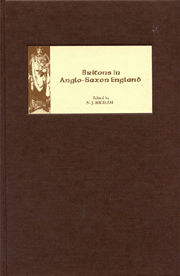Book contents
- Frontmatter
- Contents
- List of Illustrations
- List of Tables
- Contributors
- Dedication
- Acknowledgements
- Abbreviations
- 1 Britons in Anglo-Saxon England: An Introduction
- 2 Anglo-Saxon Attitudes
- 3 Forgetting the Britons in Victorian Anglo-Saxon Archaeology
- 4 Romano-British Metalworking and the Anglo-Saxons
- 5 Invisible Britons, Gallo-Romans and Russians: Perspectives on Culture Change
- 6 Historical Narrative as Cultural Politics: Rome, ‘British-ness’ and ‘English-ness’
- 7 British Wives and Slaves? Possible Romano-British Techniques in ‘Women's Work’
- 8 Early Mercia and the Britons
- 9 Britons in Early Wessex: The Evidence of the Law Code of Ine
- 10 Apartheid and Economics in Anglo-Saxon England
- 11 Welsh Territories and Welsh Identities in Late Anglo-Saxon England
- 12 Some Welshmen in Domesday Book and Beyond: Aspects of Anglo-Welsh Relations in the Eleventh Century
- 13 What Britons Spoke around 400 AD
- 14 Invisible Britons: The View from Linguistics
- 15 Why Don't the English Speak Welsh?
- 16 Place-Names and the Saxon Conquest of Devon and Cornwall
- 17 Mapping Early Medieval Language Change in South-West England
- Index
13 - What Britons Spoke around 400 AD
Published online by Cambridge University Press: 12 September 2012
- Frontmatter
- Contents
- List of Illustrations
- List of Tables
- Contributors
- Dedication
- Acknowledgements
- Abbreviations
- 1 Britons in Anglo-Saxon England: An Introduction
- 2 Anglo-Saxon Attitudes
- 3 Forgetting the Britons in Victorian Anglo-Saxon Archaeology
- 4 Romano-British Metalworking and the Anglo-Saxons
- 5 Invisible Britons, Gallo-Romans and Russians: Perspectives on Culture Change
- 6 Historical Narrative as Cultural Politics: Rome, ‘British-ness’ and ‘English-ness’
- 7 British Wives and Slaves? Possible Romano-British Techniques in ‘Women's Work’
- 8 Early Mercia and the Britons
- 9 Britons in Early Wessex: The Evidence of the Law Code of Ine
- 10 Apartheid and Economics in Anglo-Saxon England
- 11 Welsh Territories and Welsh Identities in Late Anglo-Saxon England
- 12 Some Welshmen in Domesday Book and Beyond: Aspects of Anglo-Welsh Relations in the Eleventh Century
- 13 What Britons Spoke around 400 AD
- 14 Invisible Britons: The View from Linguistics
- 15 Why Don't the English Speak Welsh?
- 16 Place-Names and the Saxon Conquest of Devon and Cornwall
- 17 Mapping Early Medieval Language Change in South-West England
- Index
Summary
Introduction
THIS article is about the contribution of historical linguistics to a reconstruction of the linguistic landscape that the Anglo-Saxons found on their arrival in Britain and to the way in which this linguistic landscape may have influenced the language of the newcomers. The bare bones are well known. British Celtic was spoken, both in the northern and western ‘Highland Zone’ and in the heavily Romanised, eastern ‘Lowland Zone’. Latin was spoken, too, especially in the Lowland Zone, although to what extent remains unclear. It has often been suggested that Latinity was probably very much a question of social status and profession: the Roman military, which came from various parts of the Empire, as well as those frequently dealing with it and with the structures of Roman power must have been fluent speakers of Latin. City-dwellers and estate owners were probably more exposed to Latin than people dwelling in the countryside and working the land. With allowance being made for local and social differentiation, it is plausibly assumed that Latin-Celtic bilingualism must have been widespread.
I propose to refine this picture in two ways. First, by arguing that, in the Lowland Zone, at least, Latin was the predominant language; and second, by presenting a case for distinguishing Lowland British Celtic from Highland British Celtic around 400 AD and for regarding the former as a Latinised variety of British Celtic with stronger connections with varieties of Celtic spoken in northern Gaul than with Highland British Celtic (it is the latter that produced the medieval languages Welsh, Cornish and Breton; the former has no offspring).
- Type
- Chapter
- Information
- Britons in Anglo-Saxon England , pp. 165 - 171Publisher: Boydell & BrewerPrint publication year: 2007

